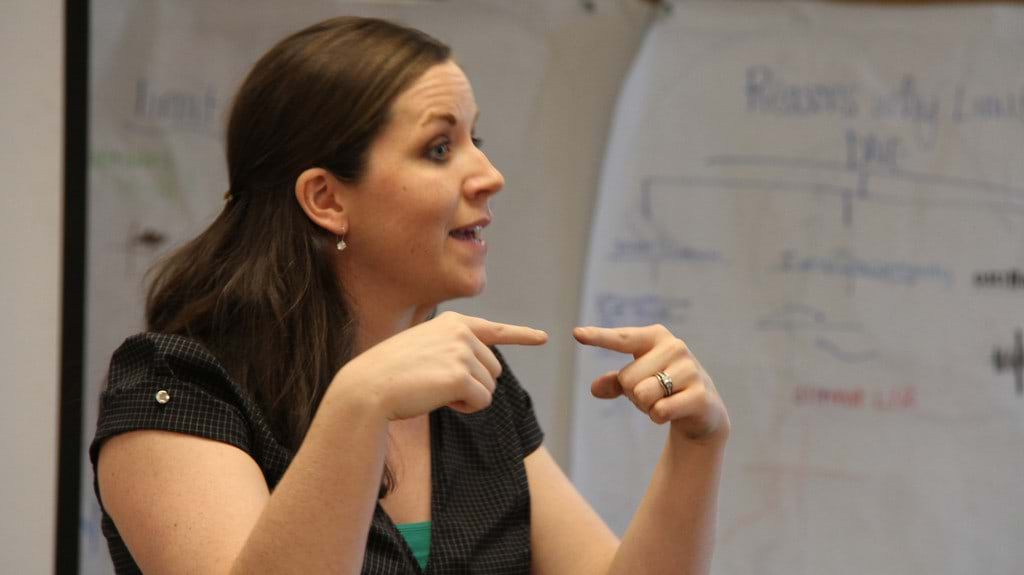Flipping with Kirch
Crystal Kirch creates short lecture videos for her math students to watch as homework. Students then come to class ready to discuss concepts and spend more one-on-one time with Crystal.
One Teacher's Journey to Effective Time with Students
What do you do when you’re presenting a lesson to 40 students and feel like you’re just not reaching them?
Crystal Kirch was faced with this dilemma. A high school math teacher at Segerstrom High School in California, Crystal could tell she wasn’t meeting the needs of her students.
“I could tell traditional teaching methods weren’t necessarily effective but it was all that I knew,” said Crystal. So she asked herself, “What is the best use of face-to-face time with my students?”

The Challenge
With this in mind, Crystal sought advice from her colleagues and began testing different teaching methods. Some things worked well and others not as much. But Crystal kept trying different approaches until one lesson fell flat. Really, really flat.
“Students went home completely unsure of what they had learned in class,” said Crystal. “So I made a quick video to review the materials we tried to cover.”
The next day, students came prepared for class. Not only did they gain better understanding of the learning activity from the day before, they were able to pause and rewind Crystal’s video to better understand the concepts they were learning. Crystal decided to make more videos to send home with students and began looking for resources online.
The Solution
Within a few weeks, Crystal was well on her way to flipping her classroom. The idea that she could send short lecture videos home with her students and use the regular class period to work with students one-on-one or in small groups made her decision obvious.
“Some students jumped on board and really liked it right away,” said Crystal, “but others struggled with the transition, simply because I had spent the first two months of school training them in the structure of a traditional class. Just as the traditional teaching model was all I knew, it was all they knew.”
Crystal continued to flip her class, spending her planning hours converting old lesson plans into 5 – 10 minute videos for students. Though the videos are short, students do not get to watch Crystal’s lessons and walk away.
“While I send short videos home with students, I still expect them to think critically about what they’re watching,” said Crystal. “I tell students to double the length of the video and add five minutes to estimate how much time they should spend on the lesson.”
As students watch the screencast, Crystal requires them to participate in the WSQ (read as: whisk) model. This means students are:
- Watching the video, pausing and rewinding when they need to go over an idea again.
- Summarizing what they watched using a Google form embedded under the screencast (Crystal gives them guided questions to promote critical thinking).
- Questioning what they learned and coming to class the next day with a question or two for Crystal to directly address.
The next day, students spend the first 10 – 15 minutes discussing what they watched the night before. After the discussion is over, students are able to branch off into small groups to work on practice questions and equations together. Crystal guides these groups as they discover answers and addresses questions one on one or with a few students at a time. Crystal’s overarching goal is to get students thinking, writing, interacting, reading, listening, and speaking (TWiRLS) in math terms.
“I didn’t want to be the only one in class thinking and speaking in math terms,” said Crystal. “I wanted to get students working within the TWiRLS model as well. By flipping my classroom and opening up the floor for collaboration between students, I am seeing this nearly every day.”
Crystal notes that many students don’t even realize they are working within the TWiRLS model because the flipped model allowed it to happen organically.

The Results
Each video takes roughly 30 minutes to record and edit. But by creating screencasts of lesson plans she was already using, Crystal is able to reuse materials each year. She now records only those lessons she wants to improve or update. Most of Crystal’s early videos were shot with a document camera, so she was not able to annotate or edit videos easily. She now uses TechSmith’s Camtasia for Mac to make new screencasts while importing old ones to edit and improve.
“The flipped classroom is a continuous process,” said Crystal. “The value of video as an instructional tool is huge. My flipped classroom will continue to evolve and grow and change to fit the needs of my students, which will be different every year.”
She is now helping other teachers at Segerstrom High School flip their classes as well as a few teachers across the school district. She is also part of the onboarding team for new teachers and shares her flipped classroom experience during their training.
To learn more about Crystal’s experience flipping her class, visit her blog Flipping with Kirch.

